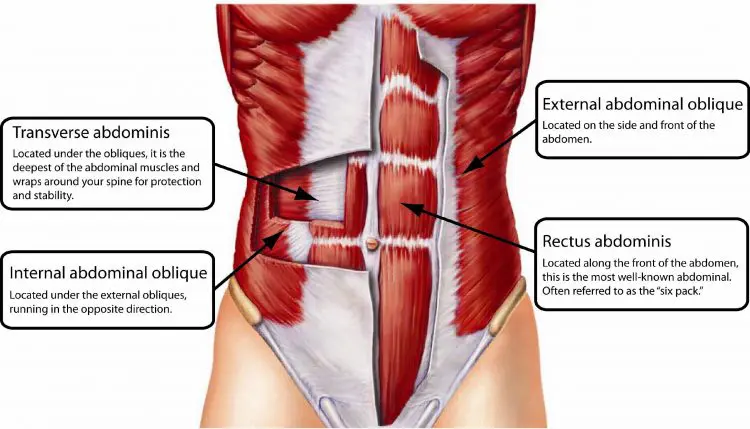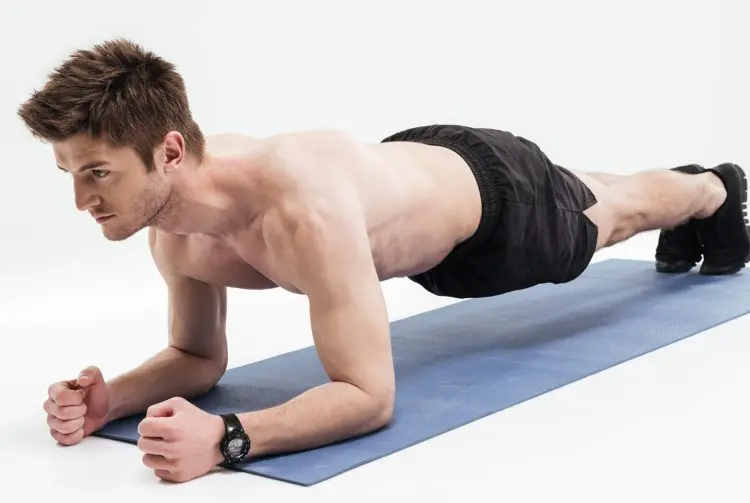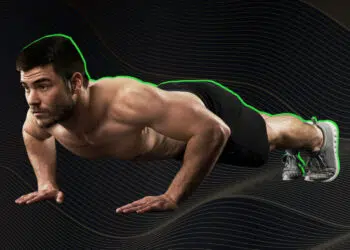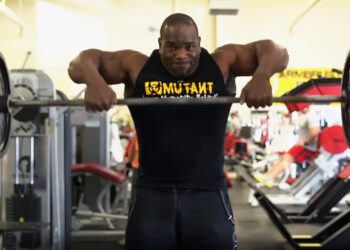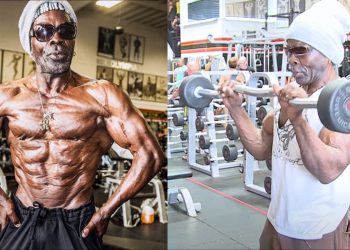When it comes to abs training, many people focus on exercises that involve spinal flexion, such as crunches and sit-ups. This makes a lot of sense, given that one of the primary functions of the abs muscles is to bend your spine forward.
However, what your abs tend to do more in nature is resist extension. That means they stop your spine from being pushed (or pulled) backward. This is an isometric or static muscle action and the very essence of “core stability.”
So, while there is certainly nothing wrong with traditional spinal flexion exercises for abs training, it’s essential to work on your static abs strength too.
In this article, we discuss one of the most convenient ways to train your abs statically – walkouts – and provide you with some great variations and alternatives to make sure your workouts never become dull.
Walkouts Muscles Worked
Walkouts work all of the muscles of your midsection, as well as some in your upper and lower body too. The main muscles involved in this exercise are:
Level Up Your Fitness: Join our 💪 strong community in Fitness Volt Newsletter. Get daily inspiration, expert-backed workouts, nutrition tips, the latest in strength sports, and the support you need to reach your goals. Subscribe for free!
Rectus abdominis
During walkouts, your rectus abdominis or abs for short works isometrically or statically to prevent lumbar spine extension. Located on the front of your abdomen, the rectus abdominis is a long, flat muscle segmented by ligamentous tissue that gives it the six-pack appearance this muscle is famous for. However, you need to be lean for this to be visible. The rectus abdominis is also involved in lateral flexion, which is not really part of the walkout exercise.
Transverse abdominis
Known the TVA for short, this muscle encircles your waist like a wide weightlifter’s belt. It contracts inward to create intra-abdominal pressure or IAP for short. IAP stabilizes and supports your spine from within, taking pressure off your intervertebral discs.
Obliques
The obliques are basically your waist or “side abs” muscles. There are two sets, internal and external, with the inner obliques located beneath the outer obliques. Their functions are lateral flexion and rotation of your spine. In walkouts, the obliques mainly work isometrically to prevent unwanted side-to-side movements.
Hip flexors
Located on the front of your hips, the hip flexors are the iliacus and psoas major muscles, collectively known as the iliopsoas. As their name implies, these muscles are responsible for the flexion of your hip and are strongly involved in walkouts.
Pectorals major and anterior deltoids
Walkouts also involve your pectoralis major and anterior deltoids, which are the muscles of your chest and shoulders, respectively. This makes walkouts more functional than many other abs exercises because, just like punching, kicking, pushing, and throwing, your arms must work alongside the muscles of your upper body.
Triceps brachii
Located on the back of your upper arms and known as the triceps for short, these muscles stop your arms bending as you walk your hands forward. While their contribution is quite small, you’ll still probably feel your triceps working during walkouts.
How to Do Walkouts
Get the most from this exercise while keeping your risk of injury to a minimum by following these steps:
- Stand with your feet together, arms by your sides. Brace your abs.
- Hinging from your hips, lean forward and place your hands on the floor. Depending on your hamstring flexibility, you may need to bend your knees a little (or a lot!) to do this.
- Taking small steps, walk your hands forward as far as you can while maintaining your core stability. Do not let your hips drop or extend your lumbar spine. Brace those abs! The further you walk your hands beyond your shoulders, the harder this exercise becomes. Hold this furthest point for a couple of seconds.
- Without relaxing your core, walk your hands back toward your feet and stand up. If you prefer, you can keep your hands on the floor and then transition immediately into another rep.
- That’s one; continue for the specified number of reps. Stop your set if you cannot maintain core stability or start to feel this exercise in your lower back more than your abs.
Walkout Benefits and Drawbacks
Walkouts are a really effective core exercise with several notable benefits:
No equipment required – you can pump out a set of walkouts anywhere and anytime as you don’t need any training equipment to do them. They’re ideal for home exercisers, but you can do them at the gym too. You don’t even need an exercise mat.
A comprehensive core workout – walkouts are a compound exercise that involves several important core muscles. Walkouts are more time-efficient than crunches and also more functional than exercises that isolate individual abs muscles.
Variable difficulty – it’s very easy to vary the difficulty of this exercise. If your core is not particularly strong, just walk out until your arms are vertical and in the push-up or high plank position. You can also do walkouts on your knees instead of from standing.
But, if you’re core is much stronger, you can walk your hands all the way out until your chest is almost touching the floor. This is MUCH more challenging.
Take note of how far forward you can walk your hands and strive to extend your range of motion to get stronger. You can also do this exercise while wearing a weighted vest to make it even harder.
While walkouts are a mostly safe and beneficial exercise, there are also a few drawbacks to consider:
Easy to overdo it – walking your hands too far forward could mean your core muscles are unable to stabilize your lumbar spine, and it starts to hyperextend. This could lead to back pain and injury. Just one step too many could be all it takes to exceed your core strength. Avoid this problem by monitoring your lumbar spine and staying within a safe range of motion. If you can feel walkouts in your lower back, you are probably overdoing it.
7 Walkout Alternatives and Variations
Walkouts are an effective and convenient core exercise that you can do anywhere and anytime. That said, they will soon lose their potency if you do them too often and may not be suitable for everyone. Keep your workouts safe and productive with these walkout variations and alternatives.
Level Up Your Fitness: Join our 💪 strong community in Fitness Volt Newsletter. Get daily inspiration, expert-backed workouts, nutrition tips, the latest in strength sports, and the support you need to reach your goals. Subscribe for free!
1. Inchworm
This exercise is a traveling walkout. Instead of moving your hands back to your feet, you walk your feet to your hands before transitioning into another rep. This is a nice variation if you’ve got a large training area.
How to do it:
- Stand with your feet together, arms by your sides. Brace your abs.
- Hinging from your hips, lean forward and place your hands on the floor.
- Walk your hands forward as far as you can while maintaining your core stability.
- Still bracing, and bending your knees as little as possible, walk your feet up to your hands.
- Without standing up, start walking your hands forward into another rep.
2. Plank
The plank is the original static core stability exercise. However, a lot of people misuse and abuse planks by doing them for too long. To be effective, instead of planking for five minutes at a time (boring!), it’s better to try and generate as much muscle tension as possible. This will save you time and is also better for increasing muscle strength and hardness.
High-intensity planks are often known as Russian Kettlebell Challenge (RKC) planks or hardstyle planks. Read about this intense and effective planking variation here.
3. TRX body saw
The TRX body saw is a challenging core exercise that’s every bit as effective as walkouts. Like walkouts, the larger your range of motion, the harder this exercise becomes. If you’ve got a TRX or another type of suspension trainer, you’re going to love this exercise.
How to do it:
- Adopt the plank position with your feet in your TRX. Brace your abs. Your upper arms should be vertical, and your shoulders, hips, knees, and feet should form a straight line.
- Use your arms to pull your body forward; this shortens the lever and takes stress off your core.
- Next, use your arms to push your body backward. This lengthens the lever and increases core tension. The further you move your body back, the harder this exercise becomes.
- Continue alternating between these two positions for the duration of your set.
4. High bird dog
Regular bird dogs are an excellent introduction to core stability training. However, the high bird dog is a MUCH more challenging exercise that easily rivals the walkout for difficulty. It’s also a good exercise for balance, increases oblique activation, and even works your glutes and lower back.
How to do it:
- Adopt the push-up or high plank position with your arms, legs, and body straight. Brace your core.
- Without twisting your shoulders or hips, lift your left hand and right foot, so they are roughly parallel to the ground. Hold this position for 3-5 seconds.
- Lower your limbs and then repeat on the opposite side.
- Continue alternating sides for the duration of your set.
- Make this exercise harder by moving your arms forward to extend your base of support.
5. Rollout
In many ways, walkouts are a bodyweight only version of the rollout exercise. The only difference being that you use an abs wheel roller or barbell instead of moving hand over hand. This results in a smoother movement. Rollouts can be done kneeling or standing, and, like walkouts, the further you extend your arms, the harder they become.
Check out our detailed guide to rollouts here.
6. Stability ball stir the pot
Inflatable stability balls wobble to destabilize your muscles which increases muscle recruitment. They also allow you to move in almost any direction, so you can work your muscles from all the available angles.
The stability ball stir the pot exercise is an excellent alternative to walkouts and combines elements of planking with rollouts and body saws.
How to do it:
- Place your forearms on a stability ball and walk your feet back until your shoulders, hips, and feet form a straight line. Brace your abs.
- Without lifting or lowering your hips, circle the ball clockwise and then counterclockwise. The larger the circle, the more demanding this exercise becomes.
- Make this exercise even more challenging by raising your feet on a chair or bench.
7. Kneeling overhead Pallof press
Pallof presses were invented by physical therapist John Palloff. Like walkouts, they involve working your upper body and core at the same time, which is how your midsection muscles tend to work in nature.
Standard Pallof presses tend to be very oblique-dominant, but this variation works your anterior core more, i.e., the rectus abdominis.
How to do it:
- Attach a rope handle to a pulley machine set to about waist height. Kneel with your back to the pulley and hold one end of the rope handle in each hand at shoulder level. Brace your core.
- Without leaning forward or backward, push your arms overhead. As you extend your arms, the tension on your abs will increase.
- Lower the handles back to your shoulders and repeat.
- This exercise can also be done standing, making it harder, but it may also increase lower back stress.
More Abs & Core Exercises:
- Cable Crunch Alternatives
- Barbell Exercises For Abs
- Russian Twists
- Best Oblique Exercises
- Bear Crawl Exercise
- Jump Rope Guide
- Calisthenics Abs Workouts
Walkouts – Wrapping Up
Walkouts are a fun but effective core exercise. With no equipment required, you can do them anywhere and anytime, making them ideal for home and gym workouts. With next to no set-up time, they’re also good for circuit training and HIIT.
Depending on how far out you move your hands, you can instantly vary the difficulty of walkouts, making this a valuable movement for beginner, intermediate, and more advanced exercisers. There are also several variations and alternatives you can use to keep your workouts interesting and rewarding.
Add walkouts to your core workouts; your abs will love you for it!
Interested in measuring your progress? Check out our strength standards for Cable Crunch, Sit Ups, Ab Wheel Rollout, and more.

